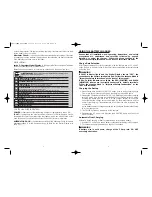
11
• If the situation persists after reconditioning and equalizing, we recommend taking
your battery to a certified automotive service center for evaluation.
F04 — Overtime Condition
Appears when charging time exceeds 18 hours. You may be using a charge current
rate too low for a large battery. Select a higher charge rate to charge the battery.
F05 — Overheated Condition
The ventilation grill that prevents the air from flowing in and out of the charger may
be blocked.
• Follow the steps outlined in “Important Safety Instructions” at the front of this manual to
disconnect AC cord and clamps, allow the unit to cool for 30 minutes and reconnect.
• Make sure there is ample ventilation before resuming operation.
F06 — Reverse Polarity
The connections to the battery’s POSITIVE and NEGATIVE terminals are incorrect.
Follow the steps outlined in “Important Safety Instructions” at the front of this manual
to disconnect AC cord and clamps and reconnect to battery with correct polarity.
F07 — Alternator Voltage
Alternator output voltage is out of typical operation range.
Charging a Very Cold Battery
If the battery to be charged is very cold (in temperatures below freezing — 0°C/ 32°F),
it cannot accept a high rate of charge. The initial charge rate will be low. The charge
rate will increase as the battery warms. Never attempt to charge a frozen battery.
SPECIFICATIONS
Boost Ampere:
450 instantaneous cranking amps
Battery Type:
Sealed, high energy density, AGM, lead-acid,
rechargeable, maintenance-free, 12 volt DC
Area Light:
Light Emitting Diode (LED)
Booster Cables:
Heavy duty welding cable with
450 Amp copper clamps
Accessory Outlet:
Self-resetting breaker 5 amps
DC Charging Adapter: 12 volt DC
10
Fuse Replacement (DC Charger Adapter)
1. Remove the plug from the accessory receptacle. Remove the gold cap by
turning counterclockwise and lifting off.
2. Remove the center pin and spring. Remove the fuse.
3. Replace the fuse with a same type and size fuse (8 amp).
4. Replace the center pin and spring inside the plug.
5. Replace the gold cap by turning clockwise onto the plug.
Battery Replacement
It is recommended that the unit be returned to manufacturer for battery replacement.
Contact Customer Service, toll-free, at (800) 618-5178.
Battery Disposal
Contains a maintenance-free, sealed, non-spillable, lead acid
battery, which must be disposed of properly. Recycling is
required — contact your local authority for information. Failure
to comply with local, state and federal regulations can result in
fines or imprisonment. For more information on recycling this
battery, call toll-free (800) 822-8837.
WARNINGS
Do not dispose of the battery in fire, as this may result in an explosion.
Before disposing of the battery, protect exposed terminals with
heavy-duty electrical tape to prevent shorting (shorting can result in
injury or fire).
Do not expose battery to fire or intense heat, as it may explode.
TROUBLESHOOTING
Display Indications/Common Problems/Possible Solutions
No Functions
• Check and make sure the charger is plugged into a live 110/120 volt AC outlet.
• Follow the steps outlined in the Operating Instructions section.
F01 — Internal Shorted Cell Battery
If the battery being charged has an internal shorted cell, the F01 will show. We
recommend taking your battery to a certified automotive service center for evaluation.
F02 — Bad Battery Connection or Battery Voltage Too Low to Accept
Charge
When F02 appears, the most common cause is poor connection to battery.
• Follow the steps outlined in “Important Safety Instructions” at the front of this manual
to disconnect AC cord and clamps, clean battery terminal and reconnect.
• If the situation persists, we recommend taking your battery to a certified automotive
service center for evaluation.
F03 — Sulfate or Unchargeable Battery
Appears when the battery is highly sulfated and cannot accept normal charge current.
• Follow the steps in “Recondition Mode” to recondition the battery.
• Follow the steps in “Equalizing” to equalize the battery.
VEC012BBD_ManualEN_020106 2/1/06 3:13 PM Page 10


























